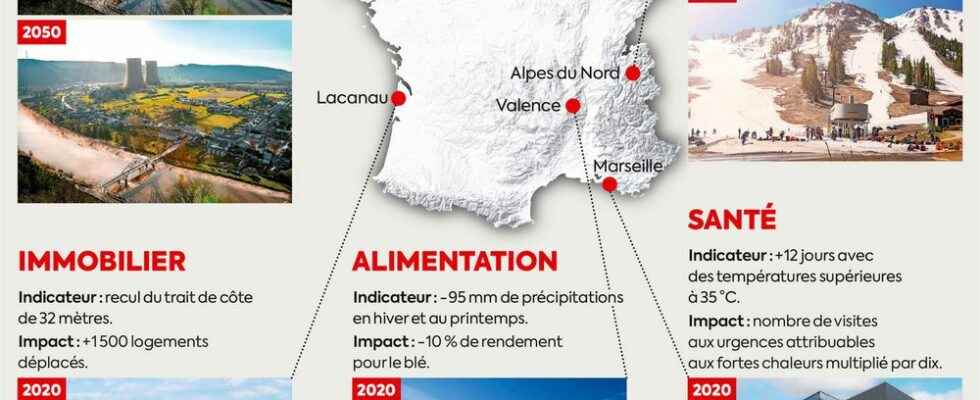This is a truth that has so far struggled to enter the public debate. A dismal omen, distant, uncertain. But the summer of 2022 has set the record straight. Drought, heat wave, fires, floods… France has just had a brutal taste of the reality of global warming. An exceptional season destined to become the norm tomorrow. And this, regardless of France’s action to reduce its emissions. “We are facing a paradox. Whatever we do in terms of mitigation or decarbonization of the economy, the climate of 2050 is already at stake for France”, explains Antoine Denoix, CEO of Axa Climate, a subsidiary of the insurance group dedicated to climate adaptation.
The reason is simple: even if all global emissions fell to zero overnight, the stock of CO2 present in the atmosphere will inexorably push mercury. According to Aurélien Ribes, Météo France researcher interviewed by L’Express last week, an increase of 2 degrees in France compared to the industrial era is possible from 2030.
And the consequences that go with it. Insurers, on the front line facing the damage caused by climate change that they must compensate, attest to this. Over the first eight months of the year, no less than 1.4 million claims were linked to various bad weather, at a cost of 5.2 billion euros according to France insurers. Never seen. On the other side of the Atlantic, in Florida, each natural disaster leads to an already very large number of households that are no longer compensated, because of insurance policies at delusional cost, or even simply the bankruptcy of insurers. Could the same thing happen in France? “For now, it’s holding,” summed up the financial director of Axa a few days ago.
What about the next twenty years? To assure is to foresee. Since 2015 and the Paris agreements, insurers have tried as much as possible to model the impact of climate change on claims. In a study carried out in 2021, France insurers estimated the total cost of natural hazards at 143 billion euros by 2050. Twice as much as over the last thirty years. For L’Express, the start-up Axa Climate has attempted to draw a portrait of France in 2050, in a scenario where the world would continue its headlong rush towards fossil fuels.
A disturbing panorama
And this, through a series of indicators ranging from energy to tourism, real estate and food through health. Displacement of 1,500 homes in Lacanau due to the rise of the ocean, explosion of visits to emergencies for high heat in Marseille, drastic drop in wheat yield in Valence…, the panorama hardly invites optimism .
3720_climate
Shutterstock – Adobe Stock/AXA CLIMATE – L’Express
And that is why, alongside the necessary reduction of its CO2 footprint, adaptation is just as urgent for a country like France, in order to reduce the impact and cost of the deleterious effects of global warming. Still, “adaptation is traditionally the poor relation in the fight against climate change. Even if mentalities are beginning to change at the level of public authorities, local communities or companies, in particular with the latest report from the [NDLR : de mars 2022] and the Climate Resilience Law, there is still work to be done”, remarks Antoine Denoix. Clearly, the theoretical foundations are there, but the action must change scale. A few months ago, the Institute of the Economy for the climate (I4CE) recommended the establishment of a budgetary investment of 2.3 billion euros each year in sectors as diverse as the preservation of water resources, the establishment of anti-submersion devices in areas coastal areas, the adaptation of towns to high heat, the assumption of additional costs to reinforce sustainable constructions in order to adapt them to drought.
Companies, which also face this systemic threat to their activities, must undergo their transformation. And quick. “For them, it’s the level of the digital transformation of the last ten years,” warns the CEO of Axa Climate. Acquiring reliable tools, knowing “the climate weather in 2030” in order to characterize and quantify the risk for them will be necessary to quickly initiate investments related to adaptation and a regenerative economy. But not enough. “Climate change is only the first of the nine planetary limits they will face. In order not to be overtaken, they must completely rethink their methods of organization and their culture”, judges Antoine Denoix. One thing is certain. The cost of inaction will always be greater than the cost of adaptation.
